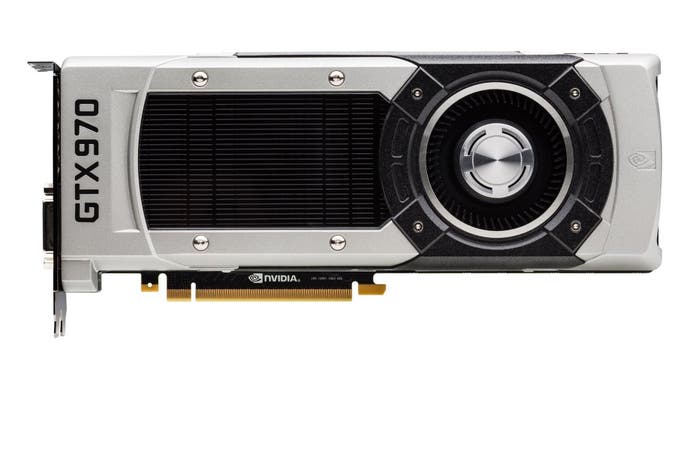Nvidia facing legal action over GTX 970 specs
UPDATE: Nvidia boss: "We won't let this happen again."
UPDATE 25/02/2015: Nvidia boss Jen-Hsun Huang has issued a statement on the controversy surrounding the company's GTX 970 graphics card.
Nvidia faces a lawsuit that alleges Nvidia "engaged in a scheme to mislead consumers nationwide about the characteristics, qualities and benefits of the GTX 970". It cites incorrect specs supplied to the tech press.
Responding, Jen-Hsun Huang said he understood why some were "disappointed", and promised not to repeat the mistake - but he stopped short of apologising.
His statement, published on the Nvidia blog, is reproduced below, in full.
ORIGINAL STORY 23/02/2015: Nvidia finds itself in hot water as the debate surrounding its GTX 970 graphics card rages on, with the firm now facing a class action lawsuit, as reported by PC World. The suit alleges that Nvidia "engaged in a scheme to mislead consumers nationwide about the characteristics, qualities and benefits of the GTX 970", citing incorrect specs supplied to the tech press. Plaintiff Andrew Ostrowski bought two GTX 970s, and apparently "soon after installing these devices in his personal computer, Plaintiff noticed that when using a high resolution monitor, the devices caused applications to slow, sputter and cease working. He also noticed that video games requiring higher levels of performance would not work properly."
We recommend Anandtech's deep-dive on the subject for a more in-depth discussion on the specs, and the implications on performance, but the bottom line is this: the GTX 970 ships with 56 ROPs, not 64 as previously indicated while L2 cache is reduced from 2MB to 1.75MB. However, the big point of contention concerns the 4GB of onboard GDDR5 memory, which is split into two partitions of 3.5GB and 512MB respectively. Bandwidth on the larger area is now rated at 192GB/s rather than the 224GB/s previously advertised. It's the last 512MB that causes the real concern though - it only runs at 28GB/s. In a world where games now often recommend over 3GB of video RAM for 1080p gameplay, the suggestion is that running at higher resolutions can see memory utilisation move into the slower area of RAM, causing stutter.
We've been looking into this issue where time allows for a while now. We've even re-benched the GTX 970 across more titles for our recent graphics card upgrade guide, and found that the card operates as it should, whether we are running at 1080p or 2560x1440 (1440p). All of our benchmarks use FCAT frame-time analysis, so every single frame output by the GPU is rated and visualised. Here we see that the GTX 970 is effectively a slower version of the 980, without any additional frame-time variance. However, there's a multitude of potential PC settings that could put more demands on the area of slower RAM, and that might cause issues.
From our perspective, there are two major issues surrounding the whole GTX 970 situation - the product's performance and trust in the vendor, Nvidia. The firm says that there was a miscommunication between the engineers and technical marketing, resulting in the wrong specs given to the press. On the one hand, the notion of a deliberate misinformation campaign doesn't seem quite right. Nvidia would have little to gain and a whole lot more lose in doing so - as we are now seeing. In terms of reviews, performance is king, and the GTX 970 would still have received excellent reviews, though perhaps the RAM issue would have been the focus of deeper investigation. On the other hand, the corrected specs only came to light once enthusiasts quite rightly kicked up a fuss about the memory allocation, and the notion that nobody at Nvidia spotted the error and corrected it does seem strange.
Trust in Nvidia in the wake of this situation is an an issue then, but this lawsuit is all about the performance deficit apparently incurred by the spec reduction. Right now, we're still testing and re-testing the GTX 970 both as a single card and in SLI, and our feeling is that it remains an exceptional product despite the controversy. On the demanding games we enjoy playing, and with those we routinely benchmark, the card runs as we would hope - and that's borne out by the analysis above. However, the partitioned memory situation clearly should be put through its paces. In revisiting the product, the question we're asking ourselves is just how the product should be tested in order to best put the 512MB partition of slow memory to the test.
In the wake of the spec correction, there are no shortage of complaints about the GTX 970 now - the GeForce forum thread is 366 pages long as of this writing, and it's an interesting and lively melting pot of discussion, outrage and first-hand reports on how to demonstrate the card's apparent inadequacies. It's as good a place as any to figure out exactly what the performance penalty of the card might actually be.
Engaging extreme levels of multi-sampling anti-aliasing or super-sampling down from higher resolutions - seemingly the preferred technique of demonstrating 970 performance issues - is mentioned a lot. This will almost certainly cause performance challenges on any card, whether you have 3.5GB or 4GB of video RAM. Even the most powerful modern GPUs are not recommended for a good 4K experience, whether they're made by AMD or Nvidia, though it is worthy of investigation for those who've invested in cards for SLI purposes, where running two cards or more in parallel should offer the horsepower required for 4K gaming at high frame-rates - when matched with reasonable quality presets.
But getting good, accurate, comparative data is the challenge here. The big question isn't really whether you can cause stuttering on the GTX 970. After all, it's a relatively easy procedure to bring any graphics card to its knees. For us, the real issue is whether we can find games that have obvious issues on the GTX 970, while running just fine on its bigger, more expensive brother - the GTX 980, with its full-fat 4GB of RAM. We'll report back with our findings, plus some thoughts from developer contacts, later this week. In the meantime, if you're a GTX 970 owner and have issues you'd like to see investigated, feel free to drop us a line.









